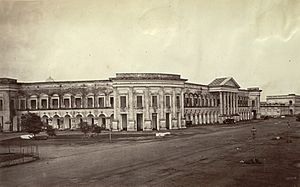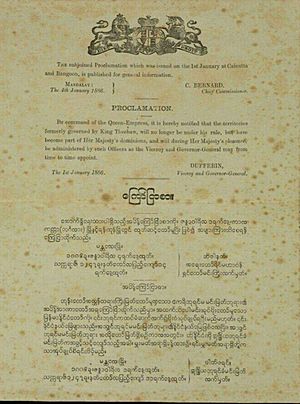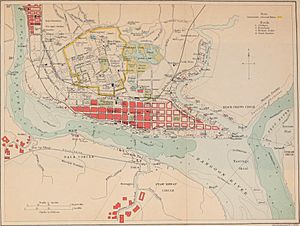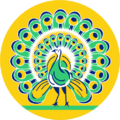British rule in Burma facts for kids
Quick facts for kids
British Burma
(1824–1886) Burma (1886–1948) မြန်မာနိုင်ငံတော် (Burmese)
|
|||||||||||||||||
|---|---|---|---|---|---|---|---|---|---|---|---|---|---|---|---|---|---|
| 1824–1948 | |||||||||||||||||
|
|
|||||||||||||||||

British Burma during World War II
Dark green: Japanese occupation of Burma Light silver: Remainder of British Burma Light green: Occupied and annexed by Thailand |
|||||||||||||||||
| Status | Division of the Bengal Presidency (1826–1862) Province of the British Indian Empire (1862–1937) Self-governing colony of the United Kingdom (1937–1948) |
||||||||||||||||
| Capital | Moulmein (1826–1852) Rangoon (1853–1942; 1945–1948) |
||||||||||||||||
| Capital-in-exile | Simla, Punjab Province, British India (1942–1945) |
||||||||||||||||
| Official languages | English | ||||||||||||||||
| Common languages | Burmese Rungtu Rohingya Meitei Hindustani Tamil Telugu Bengali Gujarati Odia Punjabi Nepalese Yunnanese Mandarin Hokkien Cantonese Hakka Standard Chinese Kedah Malay Southern Thai Northern Thai |
||||||||||||||||
| Religion | Buddhism (majority) Burmese folk religion Rungtu Animism Hinduism Islam Sikhism Jainism Sanamahism Taoism Confucianism Chinese folk religion Tai folk religion Christianity |
||||||||||||||||
| Demonym(s) | British Burmese |
||||||||||||||||
| Monarch | |||||||||||||||||
|
• 1862–1901
|
Victoria | ||||||||||||||||
|
• 1901–1910
|
Edward VII | ||||||||||||||||
|
• 1910–1936
|
George V | ||||||||||||||||
| Governor | |||||||||||||||||
|
• 1862–1867 (first)
|
Sir Arthur Purves Phayre | ||||||||||||||||
|
• 1946–1948 (last)
|
Sir Hubert Rance | ||||||||||||||||
| Premier | |||||||||||||||||
|
• 1937–1939
|
Ba Maw | ||||||||||||||||
|
• 1947–1948
|
U Nu | ||||||||||||||||
| Legislature | Legislative Council of Burma (1897–1936) Legislature of Burma (1936–1947) |
||||||||||||||||
| Senate | |||||||||||||||||
| House of Representatives | |||||||||||||||||
| Historical era | Colonial era | ||||||||||||||||
| 5 March 1824 | |||||||||||||||||
| 1824–1826, 1852–1853, 1885 | |||||||||||||||||
|
• Separation from British India
|
1937 (Government of Burma Act) | ||||||||||||||||
|
• Attained partial self-governing status within the British Empire
|
April 1, 1937 | ||||||||||||||||
|
• Japanese and Thai occupation
|
1942–1945 | ||||||||||||||||
|
• Independence declared
|
4 January 1948 | ||||||||||||||||
| Currency | Burmese rupee, Indian rupee, Pound sterling | ||||||||||||||||
| ISO 3166 code | MM | ||||||||||||||||
|
|||||||||||||||||
| Today part of | Myanmar | ||||||||||||||||
British rule in Burma refers to the time when the British controlled the country of Burma (now Myanmar). This period lasted from 1824 to 1948. It began with three wars between Britain and Burma.
After these wars, Burma became a province of British India. Later, it became a colony managed by Britain itself. Finally, Burma gained its independence in 1948. The British called the area they controlled "British Burma" or simply "Burma" after 1886.
Contents
Life in Burma Before British Rule
Before the British arrived, Burma was a rich country. It was located on important trade routes between China and India. This helped Burma's economy, even though most people farmed for their own food.
Indian traders traveled along the coasts and rivers, especially the Irrawaddy River. They brought Indian culture to Burma, which still influences the country today. Burma was also one of the first countries in Southeast Asia to widely adopt Buddhism. This religion remained very important to most people during British rule.
The ruling Konbaung dynasty had a strong central government. The king made final decisions but needed approval from the Hluttaw (the government's center). The Hluttaw had three parts: money, management, and justice. Provinces were run by governors, and villages by local leaders.
How the British Took Control
Conflict started when the Konbaung dynasty expanded into areas near British-controlled India. This led to the First Anglo-Burmese War (1824–1826). The British sent ships and easily took Rangoon in 1824.
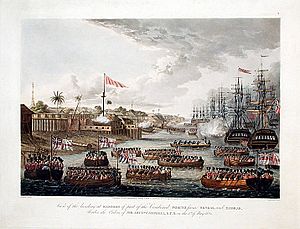
Burmese General Maha Bandula was defeated and killed. Burma had to give up some northern areas to the British. This war was very costly for the British and caused money problems in British India.
In 1852, the British started the Second Anglo-Burmese War. They wanted access to Burma's valuable teak forests and a port. After this war, the British took all of Lower Burma. They gained control of important resources like teak, oil, and rubies.

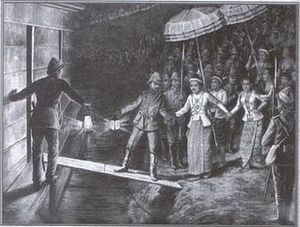
In Upper Burma, King Mindon tried to work with the British. He made changes to his government and welcomed foreign businesses. However, the British started the Third Anglo-Burmese War in 1885. They claimed King Thibaw Min was a bad ruler and was working with France.
British troops entered Mandalay on November 28, 1885. After these three wars, Britain controlled all of present-day Myanmar. It officially became a Province of British India on January 1, 1886.
Early British Rule in Burma
Even after the wars, some Burmese people continued to fight the British for several years. This resistance lasted until about 1890. The British had to destroy villages and appoint new officials to stop the fighting.
British rule changed Burmese society a lot. The king was removed, and religion was separated from the government. This was hard for Buddhist monks, who relied on the king's support. The king's power was also linked to the monks, who helped people understand national issues.
The British also started a new school system. The Government of India opened schools that taught in English and Burmese. They also encouraged Christian missionaries to open schools. In these schools, traditional Burmese culture and Buddhism were often not encouraged.
How Burma Was Governed
After 1885, the British ruled Burma directly. They divided the country into different areas. Some areas were called "Ministerial Burma" or "Burma proper." Other areas were called "Frontier Areas."
The "Frontier Areas" were home to ethnic minority groups like the Chin, Shan, Kachin, and Karenni. These areas were managed separately by the British. Later, they were joined with Burma proper to form the country we know today as Myanmar.
By 1931, Burma had 9 main divisions, which were then split into smaller districts.
Changes to the Economy
Before the British, Burma's economy focused on farming for local needs. Trade was important, but prices for goods were set by the state. When the British arrived, Burma's economy became part of the global market. It focused on exporting goods for the British Empire.
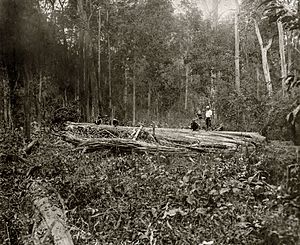
The British started using the rich soil of the Irrawaddy delta. They cleared forests to grow rice, which was in high demand in Europe. Many Burmese people moved from the north to the delta to grow rice. This changed where people lived and how wealth was created.
Farmers often borrowed money from Indian moneylenders at high interest rates. British banks did not offer loans easily. These moneylenders would quickly take over land if farmers couldn't pay back their loans.
Many Indian workers also moved to Burma. They worked for less money, which meant Burmese farmers often lost their jobs. This led to difficulties for many Burmese people. The British-owned railways and steamboats helped trade, but many Burmese did not benefit from this economic growth.
Most government jobs and military roles were given to Anglo-Burmese (people of mixed European and Burmese heritage) and Indians. Burmese people were largely kept out of these positions. Even though the country's economy grew, many Burmese people faced hardship.
Rise of Nationalism
Around the early 1900s, a movement for Burmese independence began. It started with groups like the Young Men's Buddhist Association (YMBA). These groups were allowed by the British because they seemed like religious associations.
Later, the General Council of Burmese Associations (GCBA) became more important. It connected with local "National Associations" across Burma. Educated Burmese leaders, some who studied in London, believed they could improve Burma through reforms.
In the 1920s, some changes were made, giving Burma a legislature with limited powers. Efforts were made to include more Burmese people in government jobs. However, some felt these changes were too slow or not enough.
In 1920, students went on strike against a new university law. They felt it would only help the rich and keep British rule going. "National Schools" were created in protest. This strike is now remembered as 'National Day'. Buddhist monks also became important political activists during this time.
In December 1930, a local tax protest led by Saya San grew into a large rebellion. This "Galon Rebellion" lasted two years and needed many British troops to stop it. The trial of Saya San, who was executed, helped future leaders like Dr Ba Maw and U Saw become well known.
In 1930, the Dobama Asiayone (We Burmans Association) was formed. Its members called themselves thakin, meaning "master." This was a way to say they were the true masters of Burma, not the British. Another student strike happened in 1936. It started when Aung San and Ko Nu, student leaders, were expelled from Rangoon University. They later joined the Thakin movement.
Burma Separates from India

On April 1, 1937, the British separated Burma from British India. Burma got a new constitution with an elected assembly. Many powers were given to the Burmese. However, some Burmese felt this was a trick to keep them from getting more reforms like India.
Ba Maw became Burma's first prime minister. But he was replaced by U Saw in 1939. U Saw was prime minister until he was arrested in 1942 for talking with the Japanese.
In 1938, strikes and protests began in Burma's oilfields. They grew into a general strike. In Rangoon, student protesters were attacked by police, and one student was killed. In Mandalay, police shot into a crowd of protesters, killing 17 people. This period is known as the '1300 Revolution'. December 20, the day the first student died, is remembered as 'Bo Aung Kyaw Day'.
World War II and Japanese Occupation
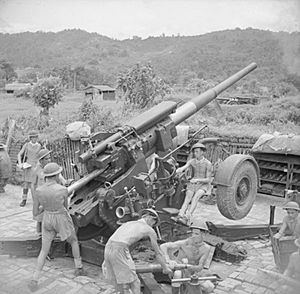
In December 1941, Japan invaded Burma. By the end of 1942, they controlled most of the colony. In 1943, the State of Burma was declared in Rangoon. It was a government controlled by Japan, led by Ba Maw.
Japan never fully conquered all of Burma. There was resistance against their rule. By 1945, British-led troops, mainly from the British Indian Army, had taken back most of Burma. Rangoon was recaptured in May 1945.
Path to Independence
After Japan surrendered, the British military took control of Burma. The British wanted to try Aung San and others for working with the Japanese. But Lord Mountbatten realized that Aung San was too popular for a trial.
The British governor, Sir Reginald Dorman-Smith, returned. His government focused on rebuilding the country. They delayed talks about independence. The Anti-Fascist People's Freedom League (AFPFL) opposed the government, causing political problems.
In September 1946, the Rangoon police went on strike. This strike spread to other government workers and almost became a general strike. The new governor, Sir Hubert Rance, calmed the situation. He met with Aung San and convinced him and other AFPFL members to join the governor's Executive Council.
This new council had more trust from the people. They began talks for Burma's independence. These talks were successful, leading to the Aung San-Attlee Agreement on January 27, 1947.
Not everyone was happy with the agreement. Some communist groups went underground, and some conservative groups opposed it. Aung San also made an agreement with ethnic minorities for a unified Burma at the Panglong Conference on February 12. This day is now celebrated as 'Union Day'.
The AFPFL, led by Aung San, won a huge victory in the April 1947 elections. However, a terrible event happened on July 19, 1947. U Saw, a former prime minister, arranged the assassination of Aung San and several of his cabinet members. This day is now remembered as Martyrs' Day.
Thakin Nu became the new leader. He led Burma to full independence from Britain on January 4, 1948. Burma chose to become a completely independent republic, not a British Dominion. This was different from India and Pakistan, which became Dominions. Many Burmese people at the time strongly felt against British rule.
Images for kids
See also






